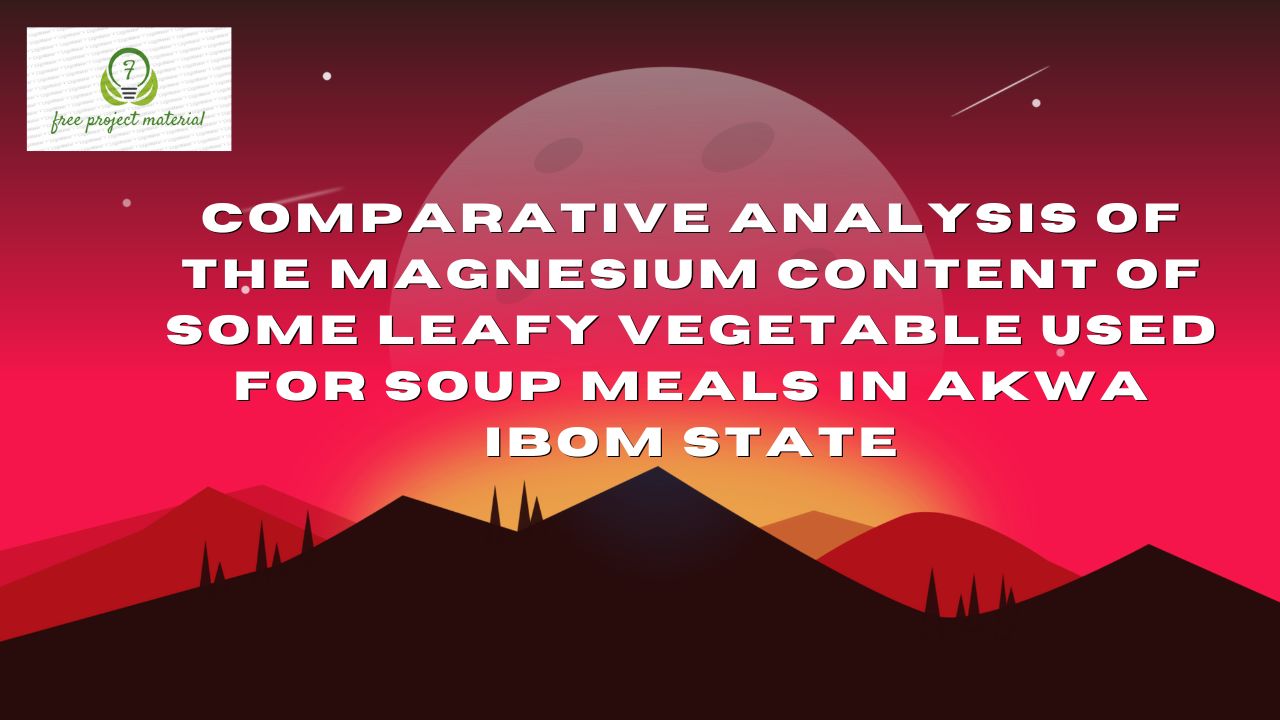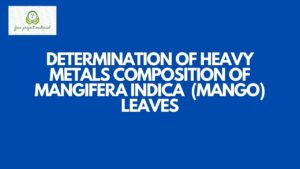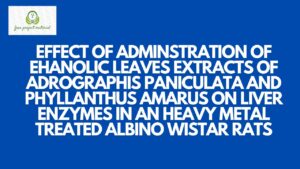ABSTRACT
This study was designed to evaluate the magnesium content of some leafy vegetables used for soup meals in Akwa Ibom State. The analysis of the samples were carried out using standard analytical procedures. The result of the analysis revealed the following Telferials occidentalis (17.25±0.219), Lasianthera Africana (19.89±0.120), Heinsia crinata (25.72±0.021), Gnetum Africana (14.41±0.156), Venonia amydalina (23.65±0.226) the trend of increase in concentration of the magnesium content in the leaves sample is Hensia crinata< Vernonia amygdalina < Lasianthera africana < Telferia occidentalis < Gnetum africana. This therefore suggest that the plants suitable to be use as supplement to improve magnesium content in the system
TABLE OF CONTENT
PAGES
TITLE PAGE – – – – – – – – i
CERTIFICATION – – – – – – – ii
DEDICATION – – – – – – – – iii
ACKNOWLEDGMENT – – – – – – – iv
ABSTRACT – – – – – – – – v
TABLE OF CONTENTS – – – – – – vi
CHAPTER ONE: INTRODUCTION
1.1 Background of the study – – – – – – 1
1.2 Aim and objectives of the study – – – – 4
1.2.1 Aim of the Study – – – – – – – 4
1.2.2 Objectives of the Study – – – – – – 5
1.3 Scope and Limitation of the study – – – – 5
CHAPTER TWO: LITERATURE REVIEW
2.1 Over view of magnesium – – – – – 6
2.2 The Nutrition and Bio-availability of Magnesium – 7
2.3 Physical and chemical properties – – – – 9
2.3.1 Physical properties – – – – – – 9
2.3.2 Chemical properties – – – – – – 10
2.4 Health benefits of green leafy vegetable – – – 11
2.5 Recommended intake of magnesium – – – 14
2.6 Sources of Magnesium – – – – – – 17
2.6.1 Food Sources – – – – – – – 17
2.6.2 Dietary Supplements – – – – – – 21
2.6.3 Medicines – – — – – – – – 22
2.7 Health Benefit s of Magnesium – – – – 23
2.7.1 Hypertension and Cardiovascular Disease – – 24
2.7.2 Types of Diabetes – – – – – – 27
2.7.3 Osteoporosis – – – – – – – 30
2.8 Magnesium Deficiency and Toxicity – – – – 32
2.9 Previous Studies on Magnesium Content
in Green Leafy Vegetables – – – – – 33
CHAPTER THREE: MATERIALS AND METHODS
3.1 Materials/Reagents – – – – – – 36
3.2 Sample Collection – – – – – – – 36
3.3 Sample Preparation – – – – – – – 37
3.4 Digestion of Sample – – – – – – – 37
3.5 Elemental Analysis – – – – – – 38
CHAPTER FOUR: RESULT AND DISCUSSION
4.1 Result – – – – – – – – 39
4.2 Discussion – – – – – – – – 40
CHAPTER FIVE: CONCLUSION AND RECOMMENDATION
5.1 Conclusion – – – – – – – – 42
5.2 Recommendation – – – – – – – 42
References
CHAPTER ONE
INTRODUCTION
1.1 Background of the Study
Vegetables are fresh edible portions of herbaceous plants which can be eaten raw or cooked and act as important sources of protective foods (Sheva et al., 2004).
Interestingly, plants produce food in the leaves, but do not store these foods in the leaves (Fasuyi, 2006). The significance of leafy vegetables have immensely been manifested in human diet supplying the body with low calories, substantial amount of carbohydrates, oil, minerals, vitamins and act as precursors of hormones as well as protein and energy (Ademipekun and Oyetunji, 2010). The elicitations of these properties by vegetables are held greatly to the biological active substances possessed by them such as secondary metabolites, high vitamin and mineral contents. They equally help in the amelioration and prevention of diseases (Farnsworth, 1996). In the Southern part of Nigeria, most people consume indigenous green leafy vegetables such as Telferia occidentalis, Ocimum grattissimum, Lasianthera africana, Heinsia crinita and Gnetum africanum.
Telferia occidentalis belongs to the family Cucurbitaceous. It is a tropical vine grown mainly for the leaves which constitute an important component of the diet of many people in West African countries (Nkang et al., 2003). The leaves are a rich source of protein, oil, vitamins, minerals, which nourish, protect and heal the body. The seeds are potentially valuable as a high protein for human and animal food. It provides an appreciable cash income to a small scale farmer. The young shoot and leaves of the plants are also used in preparing edikang ikong soup because of the pleasant taste (Fagbemi et al., 2005)
Lasianthera africana belongs to the family, Lansianthera africana and it is locally called “Editan” in Akwaibom State, Nigeria. L. africana is commonly used as antacid, analgesic, antiplasmodic, laxative, antipyretic, antiulcerogenic, anti-diabetic and antimalarial (Ekanem, 2006). The leaf extract has been reported to contain alkaloids, terpenes, saponins, tannins, flavonoids, anthraquinones and cardiac glycosides with LD50 value of 5000mg/kg (Okokon et al., 2007).
Heinsia crinita, a common vegetable in the south-eastern part of Nigeria with the local name “Atama” has been used as a component of various herbal portions in ethno-medicine. The plant part has been previously used in the treatment of umbilical hernia and skin rashes (Etukudo, 2013). There is dearth of information on the scientific rationale behind the use of this plant, but the leaf of this plant is used in cooking soup.
Gnetum africanum is referred to as Afang leaf in Akwaibom State and belongs to the family Gnetacea. It has an ellipse and small seeds. Primarily, afang leaves are used as a vegetable for soups and stews, commonly called afang soup. The leaves may be used as a remedy for nausea, sore throats, or as a dressing for warts, treatment of piles, hypertension, enlarged spleen and sore throats (Ekop, 2009). Medicinally, the stem of the plant may be eaten to alleviate pains during childbirth and possesses antiinflammatory, anticarcinogenic and antioxidant properties (Ekop, 2009).
Vernomia amygdalina (Bitter leaf) is held to be anti-sorbutic and are added to soups or eaten as spinach. An extract of bitter leaf has been shown to be ative anticancer agent. Physiologically relevant concentrations of extracts from bitter leaf inhibit DNA synthesis in a breast cancer cell line. Many part of the plants are used locally for the treatment of fever, stomach disorder, worm infestation, constipation, malaria, hiccups, kidney problems, coughs, diabetes, veneral disease, laxatives, schistosomiasis, amoebic dysentery and other bacterial and protozoal infection.
1.2 Aim and Objectives of the Study
1.2.1 Aim
The aim of this study is to carry out comparative analysis of the magnesium content of some leafy vegetables used for soup meals in Akwa Ibom State.
1.2.2 Objectives of the study
- To determine the magnesium content of some leafy vegetables used for soup meals in Akwa Ibom State namely e.g Gnetum africana, Lasianthera africana, Heinsia crinita, Telferia occidentalis.
- To discuss the implication/ significance of the results
- To make appropriate recommendations.
- To compare the result of this study with previous studies
- To give useful recommendation based on the findings.
1.3 Scope and the Study
This scope of this study covers only the determination of magnesium content in some leafy vegetables used for soup meal in Akwa Ibom Stae.



